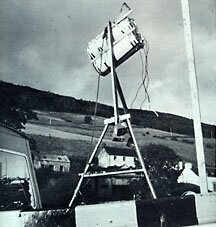
?
|
Nessie Steals our Equipment? Using MIT Professor Harold E. Edgerton's ingenioius elapsed-time stobe motion-picture camera underwater equipment, the Academy of Applied Science's scientific team set out to explore photographically the geology and life under Loch Ness in 1971. Doc Edgerton's gear was lowered into the depths of the loch and set to stobe periodically, with synchronized advance of the movie film, one frame at a time. Thousands of elapsed-time pictures were taken over many hours of unattended monitoring.
One particular adventure during this time nearly brought disaster to the whole underwater project. With the aid of British physician Maurice Shellim, the team lowered the camera gear in what was thought to be a shallow (35-foot) area of the river mouths at the westerly end of Urquhart Bay. The assembled stobe and camera cylinders and iron-pipe stand, weighting some 75 pounds, was lowered to the bottom and observed to be flashing adn pointing toward the shore. To this was attached about 50 feet of sisle rope and a red buoy. In turn, it was tethered by another 50 -foot of rope to a second red buoy; and again, by another 50-foot length to a third yellow buoy. The rig was designed in insure no matter what, we would have at least one buoy marking the site. This was done at 10 p.m. They returned to their lodgings for the evening, their minds full of what scenes might even then be exposing their film during the overnight underwater monitoring. They were to gather early the next morning to recover the camera gear in the bay. When the team assembled the next morning, Maurice was there to congratulate them on already having recovered their gear--sending off alarm bells within the team. On his way to the assembly point, he had observed no buoys in the bay, either near the camera location or elsewhere, leading him to suppose the team had already recovered the gear. They had not! They rushed to the river mouth. Maurice was right. There was not sign of the buoys, ropes or equipment. All had vanished. Suffice it to say that none of the frogmen divers, chicken-wire grappling nets, searches of the shore or extensive survey of the bay and lake from the hillsides and water patrols produced the slightest clue as to what had happened to the apparatus. The local constable agreed to institute a search on his end for possible salmon poachers or others who might have removed the gear. They assured the constable they wanted only to recover the priceless scientific gear and did not intend to press charges. The team had to break the news of the loss to Doc Edgerton, so cabled him with the first of a series of "humorous" messages calculated to prepare him for the worst, but perhaps to think the better of them, notwithstanding. Their first message read: "One sighting. Part of equipment stolen. Police helping." It was planned that the next message would reveal that the missing portion of their gear was Doc's underwater camera and stobe. And then the mystery deepened. A search boat was returning at dusk when three buoys suddenly appeared in front of it! They were colored red, red, and yellow. Unbelievably, they still had the 150 feet of rope attached and the precious strobe and camera cylinders, intact! Thus the team was able to cancel the remainder of their "conditioning" cables to Doc Edgerton and subsititue a more cheerful one. They cabled: "Nessie had stolen gear. Recovered intact. Am awaiting film development anxiously." How the gear had reached a region of the Loch at least three miles from the original mooring place, against wind and current, with buoys invisible to searchers, they could only guess. But one thing was certain. On that film would be frames showing what, if anything, had towed the apparatus underwater, or what other history it had recovered. |
 While the depths of the oceans are relatively clean and clear, allowing for excellent black and white and color flash photography over considerably ranges, the tea-colored, tannin-stained and silt-filled water of Loch Ness scatters and absorbs light so effectively that underwater photography becomes a difficult and range-limited endeavor.
While the depths of the oceans are relatively clean and clear, allowing for excellent black and white and color flash photography over considerably ranges, the tea-colored, tannin-stained and silt-filled water of Loch Ness scatters and absorbs light so effectively that underwater photography becomes a difficult and range-limited endeavor.